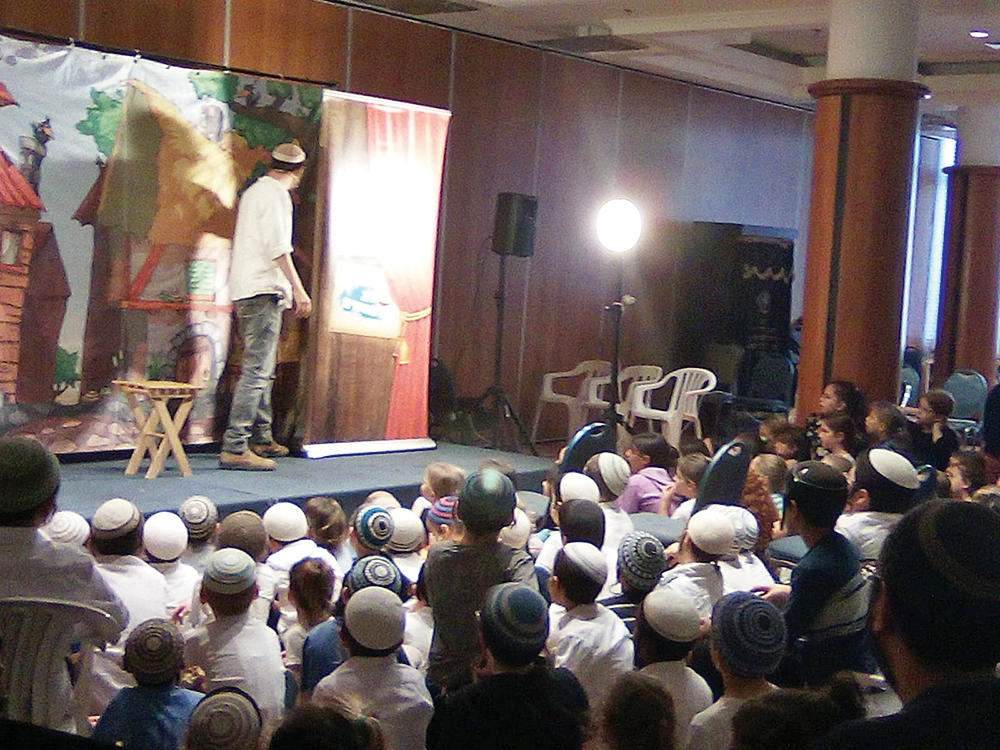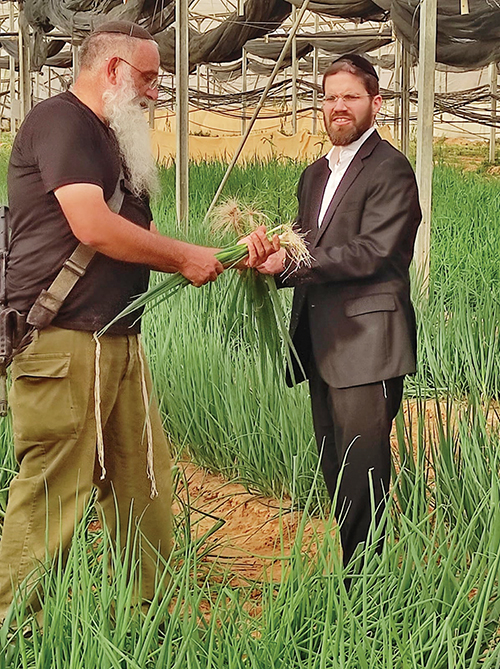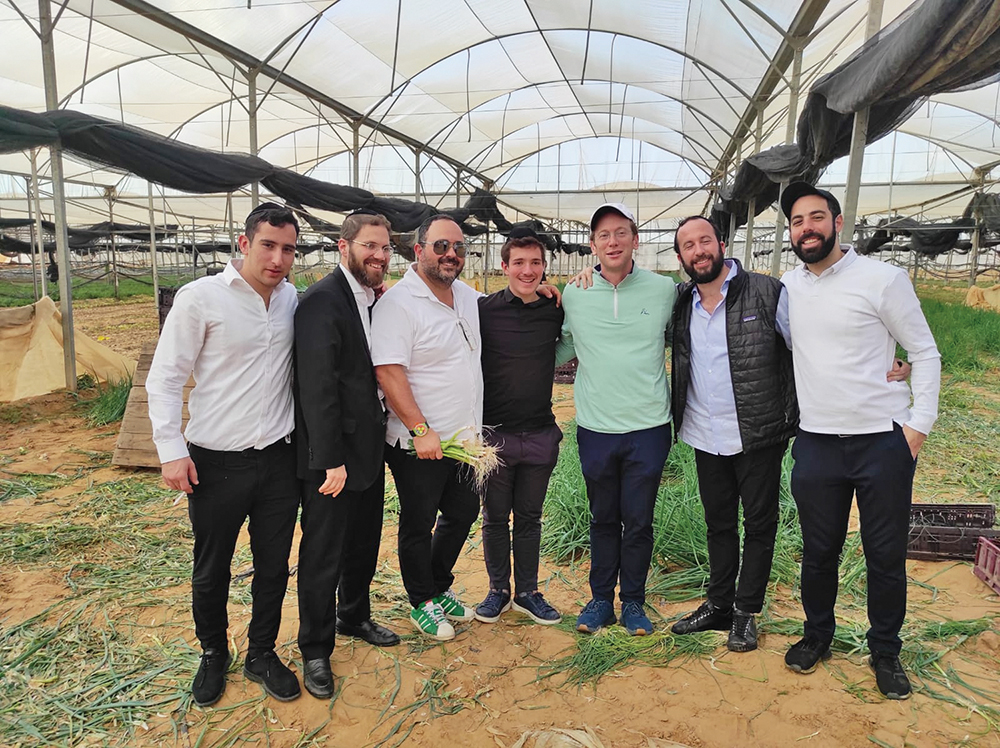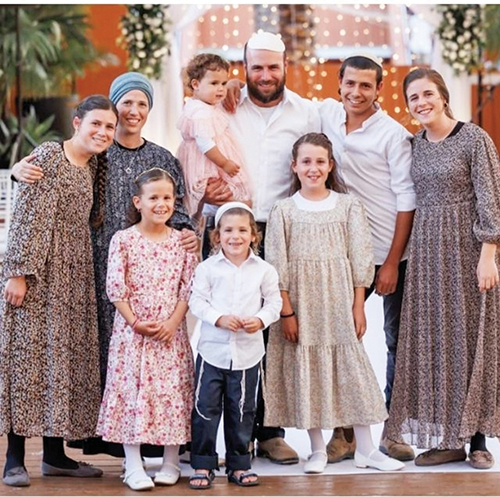
In the aftermath of October 7, Jews worldwide sought opportunities to help the IDF defeat the enemy and assist the thousands upon thousands of kibbutz residents begin to recover as they return to reestablish their communities. For Kew Gardens Hills resident Dr. Jack Walfish, this journey led to Moshav Naveh, a moshav on the southern border five miles from Gaza and two miles from Egypt in the Halutza Sands desert. Its strictly religious population pays homage to Israel’s first Chief Rabbi HaRav Avraham Yitzchak HaKohen Kook, zt”l, and his son, HaRav Tzvi Yehuda, zt”l. The consortium was established in 2006 in the aftermath of the Gush Katif disengagement; they settled in Naveh, continuing their belief of mishmar ha’gvul, defending the established borders of artzeinu hakedosha, our holy land, with a peaceful living experience by reinvigorating the sacred soil with farming and agriculture production in regions greatly underpopulated.
Here, Walfish befriended Zion Leshem, who has been working feverishly to enable the moshav to completely reopen with enhanced security procedures. Zion brought us back to that fateful day with a firsthand account that makes a donation to their rebuilding a worthy mitzvah.

With 100 of his neighbors, Zion was at the Simchas Torah vasikin minyan in the solitary shul under the direction of HaRav Mordechai Hess when red alert sirens, an all-too-common experience for moshav residents, blared without a known explanation. “It was totally out of the blue,” recalled Zion. “We had no prior communication from the army.” The calm that Naveh once enjoyed was replaced by endless nonstop wails lasting well into the day. Zion vividly described rockets flying overhead and constant explosions, sending residents to secured darkened shelters fearful of a terrorist invasion. Throughout the day, phone service was spotty at best, and electricity was eventually cut off by the terrorists. Numerous Moshav Naveh dwellings were not equipped with a safe room, as costs were exorbitant. These families, with children dressed only in their pajamas, ran under a barrage of rocket fire to the communal playground where public safe rooms were erected should a need arise.
“We spent hours waiting for the terrorists to come,” detailed Zion. A couple hours after the initial alarm, rumors began swirling originating from the neighboring towns of Kerem Shalom and Pri-Gan. Once helicopters were spotted, the community slowly began to understand the extent of the infiltration that wreaked ineffable havoc. The moshav security, widely unequipped and untrained for the unfolding events, speculated on vulnerable entry points to observe. Those with pistols patrolled the streets for as long as their petrol allowed, urging neighbors to seek secure shelter. Others positioned themselves on rooftops, scrupulously scanning for an intrusion, while others maintained vulnerable entrances.

By noon, ambulances with injured soldiers and civilian fighters sought medical assistance in Naveh, legitimizing concerns of the attack’s extent. With the sole roadway to hospital access still a one-hour trip, and blocked by terrorist activity, the Naveh community morphed their beis medrash into a makeshift incident command center, triaging incoming patients with the miniscule supplies available. Based in a caravan, these efforts were quite risky, as the structure, while sufficient to house tefillah in a serene atmosphere, was quite perilous with barely a wall separating those inside from the lurking horror. Staffed by two resident doctors and a handful of nurses, the well-positioned moshav provided lifesaving efforts into the following day when medivacs were able to land in the moshav and transport the injured to Soroka Medical Center. The deceased from nearby towns were also cared for in this center. With little information, Naveh’s populace was a sitting duck, anticipating an intrusion that thankfully never came. It was later learned that a considerable terrorist contingent headed for the community was eliminated by an IDF tank.
“For two and a half days, the people understood they were operating on their own,” said Zion. An all-clear assurance from the IDF was far from the horizon as the army rushed to organize, track, and eliminate any lingering threats. Unable to evacuate their town, residents of Naveh sheltered at home as thousands of machine-gun-bearing terrorists scavenged for prey often using their infamous pickup trucks. “There were many battle spots involving civilians,” recounted Zion of nearby hostility. “The terrorists that infiltrated were primarily from special units that knew precisely how to overtake army bases.” Israeli communication devices were overtaken by terrorists who were knowledgeable of security camera positioning, eliminating them by drone. Each group that crossed into Israel had a clear strategy tasked to kill or kidnap.
“We had an hour to get out,” recalled Zion of the IDF’s agreement that Monday to escort Naveh residents south along the Egyptian border so the IDF could function unimpeded. Hastily, Yerushalayim hotels were phoned until the management of the Shalom Hotel agreed to house the community’s 157 families, some 1,100 people including 700 children, for an unknown duration. The hours that followed were a blur, as the town’s residents, clad in bulletproof vests, trekked throughout the day alongside IDF tanks and aerial surveillance. Thanks to hotel staff, the community remained unified during the two months that followed. “In many instances, eight to 10 children crammed into two or three hotel bedrooms, leaving little to no family time,” recollected Zion. “War is not a situation that anyone plans or welcomes, however Moshav Naveh was fortunate to only sustain extreme emotional pain. No resident was physically injured during the massacre.” Crop and hothouse maintenance were conducted on a rotational basis by dedicated community members and a volunteer team.
Once situated, the community swiftly reopened its various schooling systems poised to bring back a semblance of regular life. This endeavor relocated a handful of yeshivas for boys and girls, and their pre- and post-army institutions that attracted hundreds of students from around the country just weeks earlier to rented and allocated available space throughout Yerushalayim: Shalva for the youngest, Har Homa’s Yeshivat Har HaMor for the mechina, and Yeshivat HaKotel for the yeshiva high school.

Countless volunteer hours and sizable finances allowed the youth and seniors to ease their minds with in-house crafts, visits from musicians, and local outings. Visitors from around the world, and praiseworthy groups from the New York/New Jersey area, brought a warmth and achdus that instilled hope in the evacuees. “Our insistence of staying together amongst family and friends was significant in the moshav’s ability to operate their schools in these truly tough times,” noted Zion.
In the last couple of weeks, the IDF announced the reopening of their town. Roughly 500 residents have returned, while others found housing in available apartments elsewhere until their return can be finalized. To date, no resident has come forth with plans to relocate. “The region feels like a warzone with the Israeli Air Force prevalent overhead, and army personnel steadily maneuvering,” said Zion of their current predicament. The moshav leadership has begun to handle the installation of a robust security camera network amongst other immediate safety needs including the purchase of bulletproof vests and tactical helmets, two night-vision drones, and extensive training for security personnel, but are in dire need of funding as residents find a sense of safety as measures are taken to protect themselves. Their Emergency Security Squad, a proven first line of defense, is set to be tasked with monitoring surveillance on a 24-hour, 7-day schedule, and seeks to expand to 40 members, a giant leap from the mere seven individuals they once thought satisfactory. The moshav is also working up plans to build bomb shelters in every dwelling lacking such protection. Additionally, plans for a medical center able to triage are being drawn, as the nearest hospital is over an hour’s drive. In normal road conditions, it would take an ambulance at least a half-hour to reach the moshav. Monies for life-saving equipment, firefighting items, a water tank, search and rescue trailer, surveillance tools, and other costly particulars are required.
Congregation Beth Abraham of Bergenfield, under the leadership of Rabbi Yaakov Neuburger, is one of a handful of associations that has become a vital resource in Naveh’s rejuvenation. Rabbis Yaakov Glasser, Chaim Marcus, Yaakov Trump and Westrich were amongst rabbinical leaders who aided on visits to Israel and remain in contact as Moshav Naveh rebuilds. They are counted amongst standout individuals that have taken on this plight: Danny Abermoff, Dr. Rubin Brecher, Nachman Goodman, Laizer Kornwasser and Danny Turkel.
A turbulent political atmosphere in Israel has mutated into unity amongst Am Yisrael since Operation Swords of Iron launched fostering a national feeling of connection and love that is replicated in Jewish communities worldwide. Like the biblical shevatim, tribes, the citizens of Moshav Naveh believe in a destiny that keeps their community unified. They hope their return will inspire survivors in neighboring towns to follow suit. Help realize this dream for these families faced with uncertainty and make a profound statement of the Jewish people’s strength and indomitability.
Despite Naveh’s friends and the generous help that to date, the moshav is still far from covering eminent security needs. The threat is real! Partner with Naveh now to strengthen their moshav and together we will settle the land.










